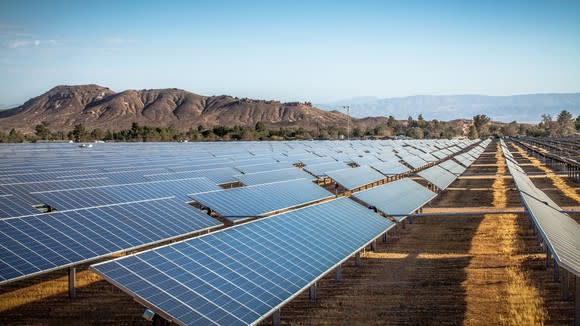China Just Dealt a Massive Blow to the Solar Industry
The solar industry has had an impressive run over the past year on strong demand for solar panels around the world. No country has been more aggressive in growing solar installations than China. Out of 99 gigawatts (GW) of solar projects built in 2017, 53 GW were built in China.
That bullish streak came to an end on Monday when China took steps to slow its solar industry. Feed-in tariffs that provide set prices for electric power sent to the grid will be cut, and distributed generation (DG) projects will be capped until further notice. Early estimates are that solar installations will fall to around 35 GW in 2018, with a lot of that already installed. The impact of the policy changes will be widespread, and no company will be spared.

Image source: Getty Images.
How China is undercutting its own solar industry
China's solar cuts were widespread and will affect most of the downstream industry. China's National Development and Reform Commission said there would be no more planned ground-mounted solar projects in 2018 and subsidies for future ground-mounted projects would be forbidden.
The feed-in tariff for solar projects was also reduced by 0.05 yuan per kilowatt-hour, a cut of 6.7% to 9% depending on the region, which will reduce the payback of solar project development. Those changes are effective June 1, 2018, so there was no notice of the cut.
Distributed solar farms were also capped at 10 GW for 2018, a level that may have already been exceeded.
Add it up and China's solar installations are going to plunge in the second half of 2018. Analysts from Roth Capital are guessing that 35 GW of installations will be built in 2018, which seems about right given the cuts. But we know demand is going to fall given China's reduced quotas and solar subsidies.
The impact on the global solar market
Solar panels are priced almost entirely based on supply and demand, and for the past year, demand has been high. According the GTM Research, solar panel prices were $0.38 per watt in the first quarter of 2017 but jumped to $0.48 per watt in the fourth quarter of 2017. Developers in the U.S. and China were rushing to complete projects before tariffs hit the U.S. and feed-in tariffs were changed in China, so they were willing to pay up for solar panels.
Beginning this summer, we'll likely see the supply-demand trend reverse. Demand is going to fall and prices could go with it. Roth Capital estimates the solar market will be oversupplied by 34 GW of panels.
The impact will have ripple effects across the industry. Major manufacturers like Canadian Solar (NASDAQ: CSIQ), JinkoSolar (NYSE: JKS), Hanwha Q Cells (NASDAQ: HQCL), and JA Solar (NASDAQ: JASO) will see margins squeezed as volume and sales prices fall. They were all enjoying higher margins and strong demand in early 2018, so the could reverse to net losses later this year.

Image source: First Solar.
We can also expect First Solar (NASDAQ: FSLR) to be negatively impacted, as it competes against lower-priced competition. No company has benefited as much as First Solar from tariffs in the U.S. combined with high panel prices, but that could soon change. If Chinese solar panel prices fall to $0.38 or less, they'll be competitive against First Solar, even with a 30% tariff.
Even SunPower's (NASDAQ: SPWR) premium-priced high-efficiency solar panels will have a little more competition as Chinese manufacturers look to dump solar panels on anyone who will buy them. That could have a negative impact on commercial and residential solar margins. The flip side is, SunPower could leverage oversupply of solar cells to lower the cost of its P-Series solar panels, which assemble commodity cells using a shingling method to create solar panels that are slightly more efficient than competing panel assembly methods. A reduction in raw material costs could be welcome news for P-Series sales. All told, I don't see China's announcement as a positive for SunPower, but it may have slightly less negative margin impact than competitors.
Solar is thrown for another loop
Solar stocks seem to get dealt a wild card like this every once in a while, but the surprise is that it's coming from China. As the largest source of demand in the world, China was the one country manufacturers could count on to fuel growing solar demand. That may not be the case now, and investors should expect economics 101 to drive solar panel prices -- and therefore manufacturer margins -- lower in the second half of the year. And no manufacturer will be spared from the pricing pressure.
More From The Motley Fool
Travis Hoium owns shares of First Solar and SunPower. The Motley Fool recommends First Solar. The Motley Fool has a disclosure policy.

 Yahoo Finance
Yahoo Finance 